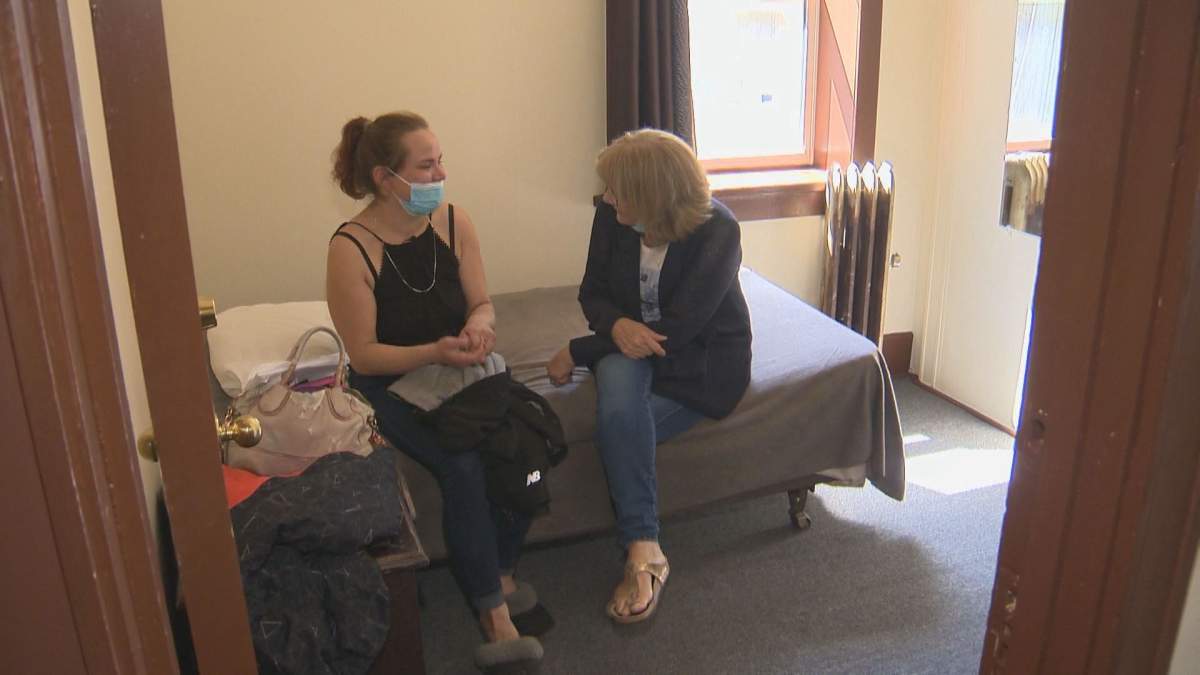Morberg House, a transitional residence supporting men struggling with addictions, homelessness and mental health challenges, is marking five years since it first opened its doors.

“Morberg House basically opened and launched on a wing and a prayer. I made a commitment — five years, we could either make it or break it,” said Marion Willis, the founder and executive director of St. Boniface Street Links and Morberg House.
“Turns out, we’ve not only done it but we’ve developed some really impactful programming that has impacted a number of lives. More than 500 men have been through our Morberg House recovery program.”
Willis says they’ve had to tackle their fair share of hurdles over the years to keep the house open and the program afloat.
“This year the greatest milestone of all is actually to receive funding from the City of Winnipeg and End Homelessness Winnipeg to deliver a fully-funded outreach effort to all neighbourhoods east of the Red,” she said.
Alexander Thomas is one of the residents currently living at Morberg House. He first learned about Morberg House last year while incarcerated at Brandon Correctional Centre.
While he wasn’t able to get into Morberg House directly, he kept in touch with Willis throughout a difficult year where he would cycle through correctional facilties, detox centres, relapses, and the streets.
“It was a really tough time for me at that point, I was struggling through that process,” Thomas told Global News. “I kept in contact with (Marion), I was back on the street, and did what I needed to do to obtain my dope or substance.”
Thomas is now staying at Morberg House as part of his bail program. He has now been sober for three months, and says he has found a new sense of purpose and meaning in life.
“Since I’ve been here and I’ve been able to deal with my issues of addiction and have that taken away from me, (I have) that contentment and feeling of peace has filled a void,” Thomas said.
“Morberg has made a world of difference because it gives me the opportunity to be content and humble and to sit here and realize all of the skills that I do have and have forgotten about because of the hectic lifestyle of the streets. There’s no place like this.”
Lived experience

Get breaking National news
Morberg House operates with a lived-experience model. Many of its staff, outreach workers and volunteers have struggled addictions, homelessness, and mental health challenges themselves.
“Because we took our learnings from those who were struggling with addiction and poor mental health, we would then just naturally develop a model that relied on lived experience for everything, because they really were the best teachers and I’ve never learned more from anybody,” Willis said.
“I’ve never learned more than I’ve learned from the population that I serve.”
One of those people is Robert Lidstone, a lived experience board member with St. Boniface Street Links.
“I was experiencing homelessness. I was struggling with an undiagnosed, untreated bipolar disorder and had a very serious meth addiction, which is continuing to be a struggle at times,” Lidstone said.
“But I am very grateful to this organization for helping me stabilize on several occasions, and it’s really the quality of relationships that defines this place. It is person-centered instead of system-centered. So rather than people getting lost through the cracks this place really connects the dots for people.”
Lidstone has a Masters in human geography from Simon Fraser University. He now uses his research background with his lived experience to give back as part of the St. Boniface Street Links team.
“I’ll be honest, it’s something I really enjoy, but also a way back into employment and that’s really a big part of our model is we offer people who have become disconnected from the workforce a chance to re-discover their skills or to hone new skills,” he said, adding he hopes the Morberg House model becomes more widely replicated in the future.
“It’s less expensive, it’s more humane, and it’s more effective,” Lidstone said. “The outcomes are better for public safety and personal wellness, and we need to start investing in this Morberg House model as a way to address those various problems.”

St. Boniface Street Links outreach
Many of the outreach workers with St. Boniface Street Links, the organization behind Morberg House, also have lived experience.
“I was a homeless youth. So I spent like three years on the streets, and now that I can give back — I’m a single parent and I have five children — so now that I can give back this is exactly what I like to do,” outreach worker Alexia Legere said.
Legere says working with St. Boniface Street Links continues to be a healing process for herself, as well.
“I’m a recovering addict. I started working with Street Links and I actually had a relapse, but Marion offered if I went to treatment for four months I could get my position back,” Legere said.
“So I went to BHF (Behavioural Health Foundation) and I did my treatment through there and I just started working a month ago through Street Links.”
Legere says outreach workers go to homeless encampments and bus shelters and build relationships with people on the streets, giving them food and water and eventually helping them get access to social services or get government IDs.
Lauren Munro is one of those people. Outreach workers approached her in a bus shelter about four months ago.
“They changed (my life) completely,” Munro said. “I was living on the streets, not knowing where I was going to go — no food, shelter, nothing. Knowing nobody.”
Last week, Munro got the keys to a safe place to call her own.
“Now I have somewhere to hang out and be sober, be safe, and (they) gave me a shelter over my head and food to eat. I feel so grateful. I don’t feel like I deserve it, personally.”
Faron Hall’s legacy
Morberg House officially opened on Aug. 16, 2016 as a tribute to Faron Hall, also known as Winnipeg’s Homeless Hero, who saved two people from the Red River in 2009, before sadly losing his own life in the same river in August 2014. Willis had become close friends with Hall, who helped her develop programming through St. Boniface Street Links.
“I believed in Faron Hall, I believed his story. I honour him,” Willis said. “He took the time to spend with me for two years, travelling throughout St. Boniface with me, getting to know all those people who live outside homeless here, and realizing that this was not the under-served population — it was the not-served-at-all population.
“This place is truly a tribute to Faron Hall, it was the last thing and probably the most meaningful thing that anybody could do for him. I know that if he were here today, he would be really proud of this.”












Comments